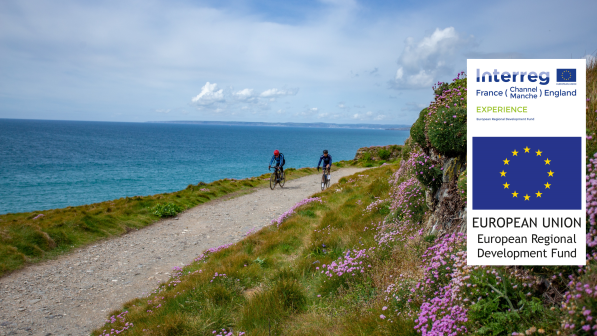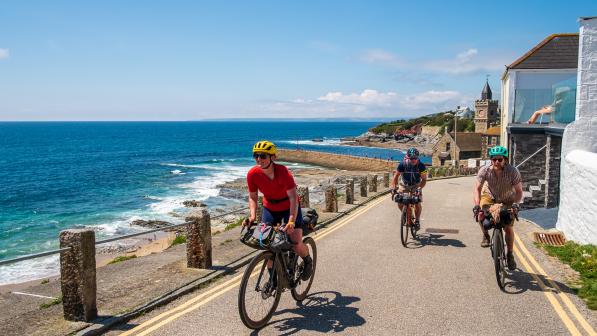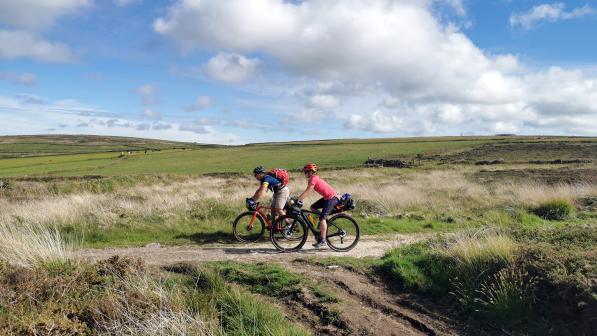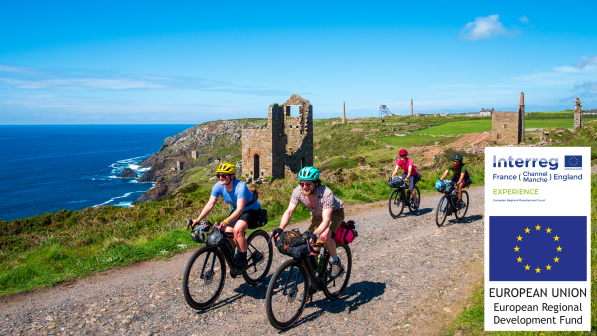Experience Helston: Mullion coves

Route overview
This 28km loop takes you winding along the western edge of the Loe on broad, well-surfaced tracks before you cross the Loe Bar itself.
You head down south along the coast on a mix of on and off-road surfaces rising and falling past several stunning coves before you get to the busy village of Mullion. Then it’s a loop back inland on super quiet rolling lanes before taking an off-road loop around the back of Culdrose airbase and down through historic Helston.
It’s the kindest route in terms of gradients, but the mix of surfaces means a gravel bike or at least a touring bike or hybrid with sturdy tyres is a wise choice. You’d be fine on a mountain bike too, but you’d likely need a fat bike to be able to ride across the Loe Bar.
This is one of three routes starting from the Cycling UK EXPERIENCE hub in Helston.
Have a look at the other routes: Gweek, Mawnan and Constantine and Porthleven and The Loe.

The Loe
Starting near the café and skate park of Coronation Park, roll carefully round the lake (duck and goose poo can be slippery) and cross the B3034, splitting left to the gate onto the bridleway almost immediately.
Follow the broad promenade under the trees, looping round in the hairpin where you come into the open parkland near Penrose House for a moment of Regency rural loveliness. Then it’s back into the trees following the western edge of the Loe, climbing gradually until the wind obliqued trees tell you you’re about to leave shelter and hit the coast.

Swinging round due west to the end of the raised sea wall, you then switchback round onto the beach and the Loe itself. You’ll probably end up pushing pretty quickly, but that lets you take in the full beauty of this rare freshwater lake which is home to several rare plant species and an overwintering site for over 80 different species of water bird.
As tempting as it looks, don’t swim in the sea here though, as the bank shelves suddenly with strong currents contributing to a local legend that someone is taken by the sea here every seven years. It’s also said that Sir Bedivere threw King Arthur’s legendary sword of invincibility ‘Excalibur’ into the Loe, a take picked up by famous English writer Lord Tennyson in his Idylls of the King poem.
The Church of Storms
Once you’ve had your fill of this breathtaking spot and tipped the sand of out your shoes, you leave the beach up a farm track climb through the tiny hamlet of Chyvarloe, topping out onto smooth tarmac where you turn left/south.
From here it’s wide, smooth roads with - if you’re lucky weather-wise - stunning views of the coastal cliffs as you scoot through Gunwalloe, Chyanvounder and past the famous and multi award-winning Halzephron Inn.
From the promise of stunning sunsets and warm fires high above the sea, you roll down to a hard reminder of the power of Cornwall’s coast. While the rocky double coves of at the bottom of the hill are ruggedly beautiful, the broodingly named ‘Church of storms’ huddling behind the headland between them is a reminder of why faith of various kinds has always been so important for those who live and die by the sea.
The immediate danger for you at this point comes not from shipwrecks or crushing waves, but from flying golf balls, so make sure to be alert and stop when sensible if someone is teeing off across the double track that climbs up and away from the beach. Presuming your helmet remains undented, the clubhouse at the top has a café for refreshments.

Otherwise, it’s a swift dive and sharp turn into Poldhu Cove where another café looks out over golden sands with a curving break that’s loved by surfers. A stiff climb brings you up onto Poldhu Point, which has been occupied from at least the Bronze Age with barrows and dagger finds to prove it.
It’s the significance of the demonstration carried out here by a young Italian called Guglielmo Marconi in 1901 that puts Poldhu on the global map though. Signals sent from here using his ‘spark transmitter’ masts were received in Newfoundland and transatlantic communication was instantly revolutionised. The site was also used to demonstrate Marconi’s shortwave radio technology in the 1920s and there’s now a small museum on the site to commemorate its place in history.
From Poldhu Cove it’s less than a kilometre to Mullion, a busy village with a lovely historic centre, church, pub, shop and public toilets. Mullion is also the jump off point if you want to follow the West Kernow Way south to the Lizard and then off on a lap of the whole peninsula. Or you can just take a short roll down to Mullion Cove with its tiny stone harbour and historic lifeboat station to take the last opportunity for a toe in the sea on this route.
Goonhilly Earth Station
Otherwise, you’re rolling north east again, down Chypons Road, a narrow lane past beautiful cottages and then dipping in and out of forgotten valleys with rich woods, ancient bridges and feet-splashing fords overlooked by the remains of prehistoric barrows and mediaeval chapels.
You’ll climb up past the gateway and wide avenue of mediaeval Bochym Manor before a quick 200m scuttle along the main road. Then you're back into splendid, wandering isolation between high flower-covered banks past more Neolithic tumuli, standing stones and a glance back to the multiple dishes of Goonhilly Earth Station.
A key site for global undersea and space communication as well as AI, computing and ‘deep thought’ development, Goonhilly is as close as you’ll get to a space station on earth. The Goonhilly Downs heathland which it sits on are a Site of Special Scientific Interest (SSSI) covered in rare plants thriving in the mild climate and isolated wildness, making this a fascinating area on many levels and well worth a detour if you don’t mind a bit of traffic.
From Bojorrow we head off-road again for a short while, straight towards the banked remains of a prehistoric hill top settlement before another up and down on tiny lanes to Garras.
Culrose Airfield
It’s a typical Cornish rollercoaster past the war memorial then down through Rosevear and up the far side before peeling off the B road towards the Culdrose airfield viewing point. Here, you can catch your breath watching helicopters or read about the significance of this airbase to navy aviation, training and coastal safety.
You’ve now got a couple of kilometres of bridleway from the aptly named hamlet of ‘Rose in the Bush’ as the final right fork part is a dense undergrowth squeeze in summer and muddy in winter. If that doesn’t sound your idea of fun, you can back track around the perimeter road from the viewing point and then take the cycle path alongside the main road into Helston.
If you don’t mind a bit of greenery or gloop though, the bridleway will open out onto a fast stretch gravel farm track that will fire you out into Mellangoose a bit too fast if you’re not careful, so take it steady.
There is a final steady narrow lane climb alongside Helston’s lush Butterfly Wood nature reserve where brown trout cruise in the crystal clear stream. Then it’s up past Flambards fun park before using the sections of cycle path to dodge the main road traffic at the roundabouts, and then roll into Helston and down the broad Georgian main street to finish.

The development of these routes has been funded through EXPERIENCE, a €23.3 million project co-financed by the European Regional Development Fund (ERDF, €16 million) through the Interreg VA France (Channel) England Programme 2014-2020, boosting visitor numbers in six pilot regions across England and France. This project will harness the experiential tourism trend to extend the season (October – March), generating 20 million new off-season visitors spending €1 billion across the Channel region by June 2023.



